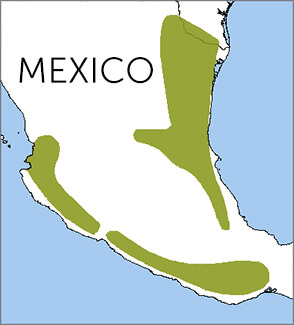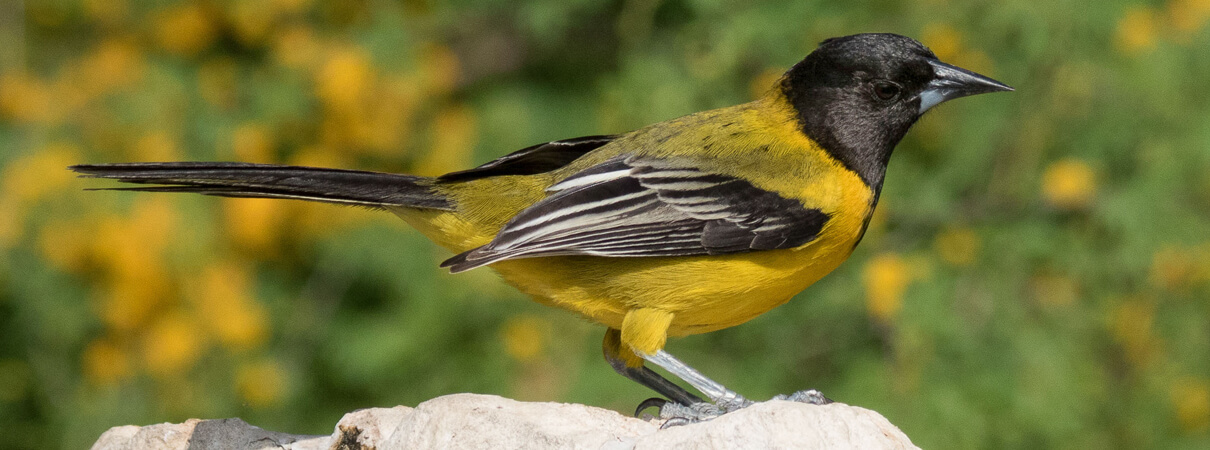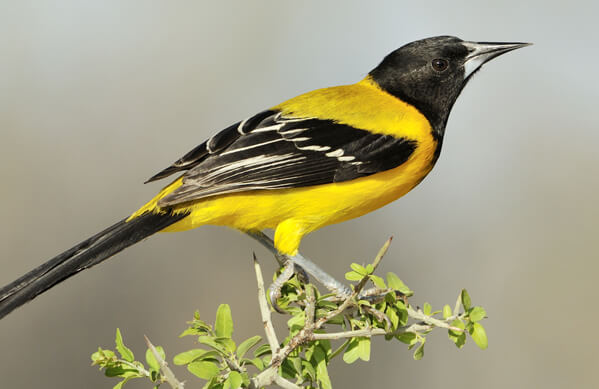 Formerly known as the Black-headed Oriole, the flashy but furtive Audubon's Oriole is one of North America's two yellow-and-black orioles. (The other is Scott's Oriole, also found in the U.S. Southwest and Mexico.) Audubon's Oriole, like the Green Jay, is a species sought after by birders visiting Texas' Lower Rio Grande Valley.
Formerly known as the Black-headed Oriole, the flashy but furtive Audubon's Oriole is one of North America's two yellow-and-black orioles. (The other is Scott's Oriole, also found in the U.S. Southwest and Mexico.) Audubon's Oriole, like the Green Jay, is a species sought after by birders visiting Texas' Lower Rio Grande Valley.
"A boy learning to whistle” is how famed ornithologist Roger Tory Peterson described the Audubon Oriole's song. (Click below to hear its slow, low-pitched whistles.)
Undercover Oriole
Although as brightly colored as a Green Jay or Painted Bunting, this large oriole can be a challenge to spot. Bright yellow is often difficult to distinguish amid green foliage, and unlike the more familiar Baltimore Oriole, Audubon's Oriole tends to remain deep under cover, where it is more often heard than seen.
Audubon's Oriole has four recognized subspecies, only one of which is found in the United States. All of their populations are nonmigratory, although some birds may make short seasonal movements.
Sign up for ABC's eNews to learn how you can help protect birds
Gaping for Grubs
Audubon's Orioles feed on a variety of insects, spiders, fruit, and nectar. They often venture into backyards to visit feeders for nectar or sunflower seeds.
With an unusual feeding behavior known as "gaping," this bird pushes its bill into a crack in dead wood or cacti, then uses strong muscles at the base of the bill to lever the crack open, revealing invertebrate prey. Other members of the icterid family, including blackbirds and meadowlarks, also use gaping behavior while foraging.

Audubon's Oriole, Mission Texas. Photo by Bettina Arrigoni
Whistler at Risk
Habitat loss is a major threat to this oriole throughout its range, since it prefers dense, unfragmented cover. Like the Black-capped Vireo and Golden-cheeked Warbler, Audubon's Oriole is frequently parasitized by Bronzed and Brown-headed Cowbirds.
Despite adult orioles' aggressive defense of their nests, a study in Texas showed that more than half of all Audubon's Oriole nests had cowbird eggs in them.
Take Action for Audubon's Oriole
ABC is helping to conserve and restore the riparian forests favored by Audubon's Oriole, Yellow-billed Cuckoo, and Least Bell's Vireo through our partnership with the Rio Grande Joint Venture.
In Mexico and farther south, we promote shade-grown coffee farms, which can provide habitat for Audubon's Oriole and migratory species such as the Wood Thrush and Chestnut-sided Warbler.
Proposed plans for a border wall between the United States and Mexico may impact Audubon's Oriole, as the wall might be built through Santa Ana National Wildlife Refuge, Bentsen-Rio Grande Valley State Park, or other protected areas, destroying crucial wildlife habitat. The state park, part of the World Birding Center, could be at risk of closure if current plans for the wall proceed.
ABC urges concerned citizens to contact their members of Congress and urge them to oppose a border wall through the refuge, state park, and other protected lands. Find out how to contact your elected officials here.
Sign up for ABC's eNews to learn how you can help protect birds



















































